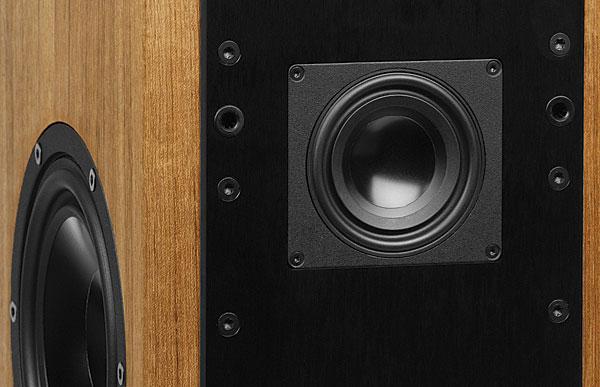| Columns Retired Columns & Blogs |
Audience ClairAudient 2+2 loudspeaker

It seems the obvious way to build a loudspeaker: one driver, no crossover, full range.
Instead, most speakers work this way: Complicated electronics split the audio signal into pieces, adding various colorations and phase shifts along the way. The pieces are distributed to different drivers, each of which adds another unique set of characteristics. We then expect these fragments of electronic signal to be brought together again in a continuous, coherent reproduction of music. We agonize over different cable routings or which contact cleaner to use, and yet we calmly accept this grotesque sausage-making way of building speakers. It's ludicrous.
The problem, of course, is that the sciences of physics, electronics, and materials conspire to make it difficult to create a driver that effectively covers the entire audioband with a satisfyingly wide dynamic range. Tweeters need to move quickly, which requires that their drivers be small and light. Woofers need to move a lot of air, which means large elements moving considerable distances. Even so, two of the best-sounding speakers I have heard—the Acoustat 2+2, and the MartinLogan CLS—were crossoverless designs.
It's not surprising that both of those classic full-rangers used electrostatic drivers. Electrostatic membranes are nearly massless, which means they're light enough to reproduce high frequencies, and large enough to move the air necessary for low frequencies and realistic volume levels.
Audience's John McDonald and the late Richard Smith approached the challenges of crossoverless design in a different way. Rather than an electrostatic element, Audience developed a novel moving-coil driver with the performance characteristics they wanted. The Audience A3S is a 3" metal-cone driver unlike any other. It starts with a patented dual-gap motor assembly that includes an oversize neodymium magnet structure and cooling gaps similar to those seen in high-powered subwoofers. The cone itself is made of a proprietary aluminum-magnesium alloy chosen for its stiffness and low mass, and anodized for a more consistent surface finish. Even the designs of the basket and driver surround are unique, and the subjects of additional patent applications.
With a full-range driver, however, there's the issue of its increasing directionality as the frequency increases. Once the size of the diaphragm becomes comparable to the wavelength of the sound it emits, its radiation pattern narrows. MartinLogan addressed this problem by using a novel, curved electrostatic panel to simulate a line source: the Curvilinear Line Source (CLS). Acoustat used two tall, narrow panels, angled them away from each other, then stacked another two on top of them to reinforce the line-source behavior—hence the model's name, 2+2. [In the Quad ESL-63, Peter Walker's follow-up design to the original Quad electrostatic, he used electronically delayed wavefronts to simulate a point source and thus sidestep the problem altogether.—Ed. ]

Here, too, Audience's approach is a little different. Even a driver 3" in diameter will become very directional above 4kHz or so, so Audience decoupled the drive-unit's dustcap with a compliant mounting so that is acts as a pseudo-tweeter, with an appropriately small radiating diameter. The concept is similar to the "mechanical crossover" the late Jim Thiel used to create a compound midrange/tweeter element for Thiel Audio's CS2.4, but Audience's implementation is a bit different.
The result is a driver with very impressive specs. With a moving mass of only 2.5gm, the A3S is indeed light and fast. The combination of its light, stiff diaphragm and segmented, oversize magnet is claimed to produce a linear, very pistonic response with 12mm of usable excursion, enough to move a lot of air. Audience claims that the driver has exceptional power handling, with less than 1dB of compression at 95dB. The A3S's native impedance is said to be fairly high, which means that multiple units can be combined and still present an amplifier with a manageable load.
2+2 = $5000
The size, shape, and radiating characteristics of the A3S driver allow several of them to be stacked and the arrays mounted back to back. The ClairAudient 2+2 is a bipole speaker, however, not a dipole; its rear- and forward-firing drivers are in phase with each other. The 2+2 has four A3S drivers—hence the model name—and a price of $5000/pair. Other Audience models have as many as 32 drivers. The 2+2 augments the low-frequency output of the four AS3 drivers with a 6" passive radiator, mounted on one of the enclosure's sidewalls. Each pair is supplied as mirror-imaged samples, and the 2+2s are intended to be set-up with the two passive radiators facing each other.
- Log in or register to post comments




































